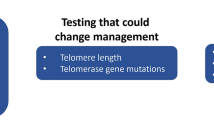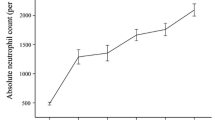Abstract
Aplastic anemia (AA) is most frequently due to autoimmune attack on its own stem cells. Alemtuzumab is a monoclonal antibody which recognizes the CD52 antigen on the surface of T and B cells. It has proved useful in autoimmune diseases, lymphoproliferative conditions, and graft versus host disease. Based on its immunosuppressive properties, we treated 14 AA patients with alemtuzumab. Median age was 23 years. Ten milligrams of alemtuzumab were injected subcutaneously each day for five consecutive days. Cyclosporine A was also administered orally at a dose of 2 mg/kg every 12 h for 3 months, and then gradually tapered. Response to alemtuzumab was followed for a median of 20 months. There were eight responses (57.1%), two complete and six partial. Whereas six (42.8%) patients were non-responders. Median complete blood count values on alemtuzumab responders were Hb 13.1 mg/dL, absolute neutrophil count 2.4 × 109/L, and platelets 97.5 × 109/L. A good response was produced in 57% of AA patients with the administration of alemtuzumab, who lacked a stem cell donor.

Similar content being viewed by others
References
Marsh J (2006) Making therapeutic decisions in adults with aplastic anemia. Hematology Am Soc Hematol Educ Program 2006:78–85
Young NS, Calado RT, Scheinberg P (2006) Current concepts in the pathophysiology and treatment of aplastic anemia. Blood 108:2509–2519
Marsh JC, Ball SE, Darbyshire P et al (2003) Guidelines for the diagnosis and management of acquired aplastic anaemia. Br J Haematol 123:782–801
Jaime-Perez JC, Ruiz-Arguelles GJ, Gomez-Almaguer D (2005) Haematopoietic stem cell transplantation to treat aplastic anaemia. Expert Opin Biol Ther 5:617–626
Brodsky RA, Jones RJ (2005) Aplastic anaemia. Lancet 365:1647–1656
Johnston B, Conly J (2006) Alemtuzumab and natalizumab: the monoclonal antibody story continues. Can J Infect Dis Med Microbiol 17:327–329
Villamor N, Montserrat E, Colomer D (2003) Mechanism of action and resistance to monoclonal antibody therapy. Semin Oncol 30:424–433
Willis F, Marsh JC, Bevan DH et al (2001) The effect of treatment with Campath-1H in patients with autoimmune cytopenias. Br J Haematol 114:891–898
Marsh JC (2007) Treatment of acquired aplastic anemia. Haematologica 92:2–5
Issaragrisil S, Kaufman DW, Anderson T et al (2006) The epidemiology of aplastic anemia in Thailand. Blood 107:1299–1307
Kaufman DW, Kelly JP, Jurgelon JM et al (1996) Drugs in the aetiology of agranulocytosis and aplastic anaemia. Eur J Haematol 60:23–30
Montane E, Ibanez L, Vidal X et al (2008) Epidemiology of aplastic anemia: a prospective multicenter study. Haematologica 93:518–523
Ruiz-Arguelles GJ, Gomez-Rangel JD (2003) Long-term results of the immunosuppressive treatment of patients with severe acquired aplastic anemia: a single institution study. Acta Haematol 110:184–187
Benitez-Aranda H, Velez-Ruelas MA, Diaz-Cardenas S et al (2002) Incidence of aplastic anemia in a defined subpopulation from Mexico City. Hematology 7:229–232
Storb R, Leisenring W, Anasetti C et al (1997) Long-term follow-up of allogeneic marrow transplants in patients with aplastic anemia conditioned by cyclophosphamide combined with antithymocyte globulin. Blood 89:3890–3891
Frickhofen N, Heimpel H, Kaltwasser JP, Schrezenmeier H (2003) Antithymocyte globulin with or without cyclosporin A: 11-year follow-up of a randomized trial comparing treatments of aplastic anemia. Blood 101:1236–1242
Jaime-Perez JC, Gonzalez-Llano O, Gomez-Almaguer D (2001) High-dose cyclophosphamide in the treatment of severe aplastic anemia in children. Am J Hematol 66:71
Brodsky RA, Sensenbrenner LL, Smith BD et al (2001) Durable treatment-free remission after high-dose cyclophosphamide therapy for previously untreated severe aplastic anemia. Ann Intern Med 135:477–483
Chao MM, Levine JE, Ferrara JL et al (2008) Successful treatment of refractory immune hemolysis following unrelated cord blood transplant with Campath-1H. Pediatr Blood Cancer 50:917–919
Laros-van Gorkom BA, Huisman CA, Wijermans PW, Schipperus MR (2007) Experience with alemtuzumab in treatment of chronic lymphocytic leukaemia in the Netherlands. Neth J Med 65:333–338
Hale G, Rebello P, Brettman LR et al (2004) Blood concentrations of alemtuzumab and antiglobulin responses in patients with chronic lymphocytic leukemia following intravenous or subcutaneous routes of administration. Blood 104:948–955
Au WY, Lam CC, Chim CS, Pang AW, Kwong YL (2005) Alemtuzumab induced complete remission of therapy-resistant pure red cell aplasia. Leuk Res 29:1213–1215
Rzepecki P, Sarosiek T, Szczylik C (2006) Alemtuzumab, fludarabine and melphalan as a conditioning therapy in severe aplastic anemia and hypoplastic myelodysplastic syndrome—single center experience. Jpn J Clin Oncol 36:46–49
Gómez-Almaguer D, Ruiz-Argüelles GJ, del Carmen Tarín-Arzaga L et al (2008) Alemtuzumab for the treatment of steroid-refractory acute graft-versus-host disease. Biol Blood Marrow Transplant 14:10–15
Ruiz-Argüelles GJ, Gil-Beristain J, Magaña M, Ruiz-Delgado GJ (2008) Alemtuzumab-induced resolution of refractory cutaneous chronic graft versus host disease. Biol Bone Marrow Transplant 14:7–9
Kim H, Min YJ, Baek JH, Shin SJ, Lee EH, Noh EK, Kim MY, Park JH et al (2009) A pilot dose-escalating study of alemtuzumab plus cyclosporine for patients with bone marrow failure syndrome. Leuk Res 33:222–231
Author information
Authors and Affiliations
Corresponding author
Rights and permissions
About this article
Cite this article
Gómez-Almaguer, D., Jaime-Pérez, J.C., Garza-Rodríguez, V. et al. Subcutaneous alemtuzumab plus cyclosporine for the treatment of aplastic anemia. Ann Hematol 89, 299–303 (2010). https://doi.org/10.1007/s00277-009-0816-5
Received:
Accepted:
Published:
Issue Date:
DOI: https://doi.org/10.1007/s00277-009-0816-5




